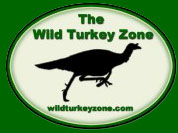|

Spring
Turkey Activity
By T.R. Michels, Trinity Mountain
Outdoors
Even though the first day of the
spring turkey hunt was cloudy, and a cold wind was
blowing I headed for the soybean field where I had
seen a flock of turkeys appear just after daylight
for the last two weeks. I was fairly sure the birds
wouldn't show up because of the weather. Just to be
on the safe side I drove to the field forty-five minutes
before daylight. I parked on the road, got out of
the suburban, and owl hooted loudly. When I didn't
get an answer I hooted again. Still no answer. I waited
several minutes as the sky grew lighter and then blew
a flydown cackle. No answer. The birds were either
not there or not talking.
Luckily, I had been researching this
particular flock for more than two years and I had
a good idea of where I could find at least two of
the fourteen jakes and toms in the area. I got back
in the Suburban and drove to a small bean field that
protected from north and east winds by the surrounding
woods. By the time I got there the sky was already
turning gray, so I grabbed my bag of Feather Flex
decoys and quickly made my way to the edge of the
woods on the west side of the small field. When I
reached the gully that ran into the field from the
north I put out two hen decoys and two toms decoys,
one in a semi-strut the other in a full strut.
I chose a large tree at the edge of
the woods, checked to make sure I had a clear line
of sight, sat down, and yelped softly on my Haydel's
box call. With the wind blowing I wasn't sure if I
could hear the birds, or if they could hear me. I
called intermittently for the next fifteen minutes
without getting a response. Then I heard a double
gobble. I called one more time and waited. I knew
the birds were calling because they kept gobbling
every two to three minutes, and each time the sound
was closer. A half hour after I set up two long bearded
toms walked down the gully, into the field and approached
the decoys. If I had been hunting the birds would
have offered an easy shot at fifteen yards.
Research
As a guide, writer and seminar speaker
it's my job to know when and where to find game animals
on a regular basis. After hunting for more than thirty
years I have learned a bit about animals. Reading
magazine articles and attending seminars also helped.
Then I began to talk to researchers and biologists
throughout the United States. After reading several
of their research papers I realized there was much
more to learn. So, I decided to begin doing my own
research.
Like most hunters I have had days when I felt I had
chosen the right day, the right spot, and the right
time to hunt, and still didn't see anything. I was
fairly sure the weather had a lot to do with game
movement because of some of the research I had read.
I knew that turkeys often roosted on the downwind
side of a hill to get out of cold winds, and from
my own experience I knew that they often flew down
later than normal on cloudy days. But, I wasn't sure
when or where the birds moved when the conditions
weren't right.
That's when I began watching the flock
of thirty-four birds a half mile from my house. For
two years I watched, listened and learned the movement
of the birds. From the middle of March to late May
I would go out in the evening to find out where the
birds roosted. The next morning I would arrive an
hour before daybreak. In a notebook I wrote down the
date, temperature, wind speed, wind-chill, sky conditions
and precipitation. Then I would record the time and
number of all the gobbles, any other calls the birds
made, how many hens, toms and jakes I saw, what they
did and when they did it, how long they did it and
where they went, from sunrise to as late as 1:30 PM.
What I learned has allowed me to see more birds, find
the birds on a regular basis, and get closer to them.
My studies show that several different
meteorological conditions affect when and where turkeys
move on a daily basis. These conditions include; the
temperature or wind-chill (whichever is lower), the
wind speed, amount and type of precipitation, and
the cloud cover.
Continued-->>>
If you are interested in more turkey
hunting tips, or more turkey biology and behavior,
click on Trinity Mountain Outdoor News and T.R.'s
Hunting Tips at www.TRMichels.com. If you have questions
about turkeys log on to the T.R.'s Tips message board.
To find out when peak turkey gobbling can be expected
in your area, click on Peak Turkey Gobbling Dates.
This article is an excerpt from the
Turkey Addict's Manual ($14.95 + $5.00 S&H), by
T.R. Michels, available in the Trinity Mountain Outdoor
Products catalog.
T.R. Michels is a nationally recognized
game researcher/wildlife behaviorist, outdoor writer
and speaker. He is the author of the Whitetail, Elk,
Duck & Goose, and Turkey Addict's Manuals. His
latest products are the 2003 Revised Edition of the
Whitetail Addict's Manual, the 2003 Revised Edition
of the Elk Addict's Manual; and the 2003 Revised Edition
of the Duck & Goose Addict's Manual. For a catalog
of books and other hunting products contact: T.R.
Michels, Trinity Mountain Outdoors, PO Box 284, Wanamingo,
MN 55983, USA. Phone: 507-824-3296, E-mail: TRMichels@yahoo.com,
Web Site: www.TRMichels.com
|

